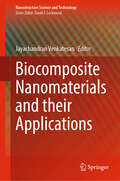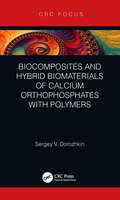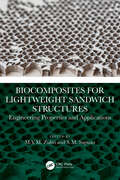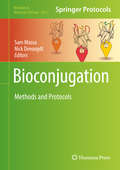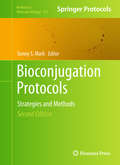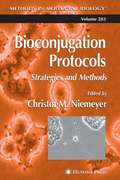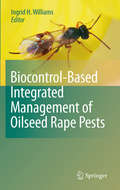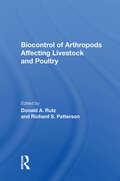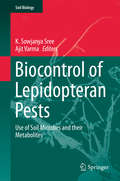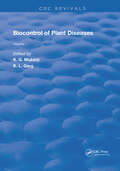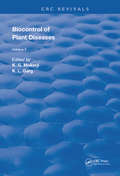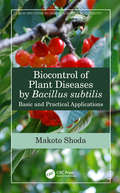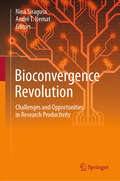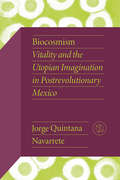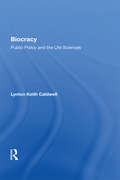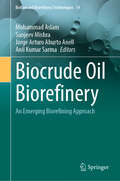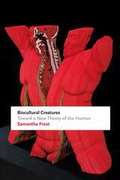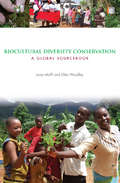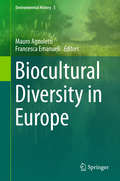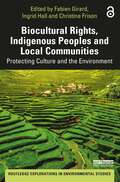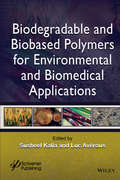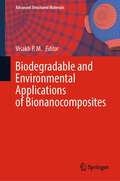- Table View
- List View
Biocomplexity of Plant-Fungal Interactions
by Darlene SouthworthPlants interact with a wide variety of organisms in their natural growing environments. Key amongst these relationships is the interplay between plants and diverse fungal species that impact plants in complex symbiotic, parasitic and pathogenic ways. Biocomplexity of Plant-Fungal Interactions explores a broad spectrum of research looking at both positive and negative interactions of these relationships on plants and their ecosystems. Biocomplexity of Plant-Fungal Interactions takes a more holistic view of the plant-fungal interactions than most traditional volumes on the topic. Focusing on the truly complex biological interplay among plants and fungi, as well as other organisms—mammals, insects, bacteria, viruses, this book provides a unique perspective on this fundamentally important relationship. Chapters are written from molecular, evolutionary and ecological perspectives to provide readers with a full understanding of the diverse implications of plant-fungal interactions. Written by a global team of experts from varied scientific backgrounds, Biocomplexity of Plant-Fungal Interactions will be an essential title for readers looking for a better understanding of the diverse array of interactions between plants and fungi in natural ecosystems.
Biocomposite Nanomaterials and their Applications (Nanostructure Science and Technology)
by Jayachandran VenkatesanThis contributed book is focused on the use of nanomaterials in biomedical applications, particularly in the development of pharmaceuticals, nutraceuticals, and cosmeceuticals. It covers a wide range of nanomaterials, including polymers, metals, and carbon-based materials, and discusses their incorporation into polymeric biocomposites to create materials with unique properties. The book overviews the various applications of these nanocomposites, including tissue engineering, drug delivery, biosensors, and packaging. It is a useful resource for research scholars, graduate students, academics, and pharmaceutical companies working in the fields of material science and nanotechnology.
Biocomposites and Hybrid Biomaterials of Calcium Orthophosphates with Polymers
by Sergey V. DorozhkinThis title gives an overview of composites and biocomposites. It discusses the history of CaPO4/ /polymer biocomposites and hybrid biomaterials, as well as analyzing the latest developments in the field. It also covers bioactivity and biodegradation of CaPO4-based biomaterials.
Biocomposites for Lightweight Sandwich Structures: Engineering Properties and Applications
by M.Y.M. Zuhri S. M. SapuanBiocomposites for Lightweight Sandwich Structures: Engineering Properties and Applications highlights how the relationship between biocomposites and sandwich structures can provide a unique combination of superior properties that can be optimized for environmentally friendly lightweight applications. It introduces current performance of biocomposites, sandwich structure applications, machining and manufacturing methods, energy-absorbing capabilities, and strengthening techniques of structures, as well as potential, challenges, and future perspectives on performance improvement. Provides latest research on biocomposites and use in lightweight engineering applications. Explores the suitability of core designs using biocomposites and related environmentally friendly materials. Includes recent manufacturing technologies and important performance criteria of sustainable materials for lightweight structures. Discusses existing commercial materials and those that are currently under research and development. This comprehensive reference will be of interest to materials, mechanical, and aerospace engineers and those working in related fields interested in development of materials for lightweight designs.
Bioconjugation: Methods and Protocols (Methods in Molecular Biology #2033)
by Sam Massa Nick DevoogdtThis book explores well-established and emerging conjugation strategies that are relevant for proteins used in the field of precision medicine, focusing on techniques that are suitable for antibodies, antibody-fragments such as Fabs, scFvs, or nanobodies, scaffold proteins such as FN3 or DARPin, peptides, or model proteins. Although centered on the development of bioconjugates rather than their application, most protocols also show the conjugation of the targeting vehicle to a diagnostic or therapeutic entity, with the end-product most often being an antibody-drug conjugate, an optical probe, a nanomedicine, or a radiopharmaceutical. Written for the highly successful Methods in Molecular Biology series, chapters include introductions to their respective topics, lists of the necessary materials and reagents, step-by-step, readily reproducible laboratory protocols, and tips on troubleshooting and avoiding known pitfalls. Authoritative and practical, Bioconjugation: Methods and Protocols is an ideal guide for researchers looking toward precision medicine in order to expand the vital field of drug discovery.
Bioconjugation Protocols: Strategies and Methods (Methods in Molecular Biology #751)
by Sonny S. MarkContemporary approaches to the synthesis of chemically modified biomacromolecules (proteins, nucleic acids, lipids, and carbohydrates) not only require efficient means to control conjugation and the specific site of attachment of the conjugated moiety but also the effective use of recent developments in the fields of pharmaceutical chemistry, biomolecular/polymer engineering, and nanobiotechnology. In this second edition of Bioconjugation Protocols: Strategies and Methods, expert researchers update the classic methods and introduce valuable new approaches that go beyond basic conjugation techniques to include elements from advanced organic synthesis, molecular biology, surface biotechnology, materials science, and nanobioscience/engineering. These readily reproducible methods cover the preparation of biomolecular conjugates using a variety of labeling techniques and semisynthetic approaches. Additional chapters address the biofunctionalization of surface structures, including organic/inorganic thin films, as well as various types of nanostructures (magnetic nanoparticles, quantum dots, carbon nanotubes, and silicon nanowire devices). All the protocols follow the successful Methods in Molecular BiologyTM series format, each one offering step-by-step laboratory instructions, an introduction outlining the principle behind the technique, lists of the necessary equipment and reagents, and tips on troubleshooting and avoiding known pitfalls. Cutting-edge and highly practical, Bioconjugation Protocols: Strategies and Methods, Second Edition offers both novice and experienced researchers access to the broad array of techniques needed to carry out the semisynthesis of functional biomolecular reagents and/or the biofunctionalization of surfaces and structures of unique interest for a wide variety of applications, ranging from novel biomedical diagnostics to powerful new therapeutics to advanced biomaterials.
Bioconjugation Protocols: Strategies and Methods (Methods in Molecular Biology #283)
by Christof M. NiemeyerExpert laboratorians update the classic bioconjugation methods and introduce valuable new techniques that go beyond pure biomedical applications to include elements from advanced organic synthesis, molecular biology, and materials science. These readily reproducible methods cover the preparation of protein conjugates using covalent and noncovalent conjugation, the synthesis of nucleic acid conjugates using a variety of labeling techniques, and approaches to semisynthetic conjugates of proteins. Additional chapters address the biofunctionalization of inorganic surfaces, including the on-chip synthesis of peptide nucleic acids to generate microarrays for the high-throughput analysis of RNA and DNA, gold nanaoparticles, and carbon nanotube probes for atomic force microscopy.
Biocontrol-Based Integrated Management of Oilseed Rape Pests
by Ingrid H. WilliamsOilseed rape is a major arable crop in both Europe and North America. It is attacked by unique complexes of insect pests still largely controlled through the application of chemical insecticides. Crop management systems for the future must combine sustainability with environmental acceptability to satisfy both social and economic demands. This book, in its 17 chapters each led by a world expert, reviews research progress towards developing integrated pest management systems for the crop that enhance conservation biocontrol. This approach is particularly timely because of the development in Europe of insecticide resistance in the pollen beetle, a major pest of the crop. The past decade has seen considerable progress in our knowledge of the parasitoids and predators that contribute to biocontrol, of their distribution patterns, and their behavioural ecology, both within and without the crop. There is potential for natural enemy conservation through modification of within-field crop husbandry practices, as well as, on the landscape scale, through habitat manipulation to encourage vegetational diversity. This book will prove invaluable as a text for researchers, university teachers, graduate scientists, extension workers and growers involved in integrated pest management.
Biocontrol Of Arthropods Affecting Livestock And Poultry
by Donald A RutzThe adverse affects of pesticides and other toxic deterrents on the environment and human health are causing researchers to investigate biological methods for controlling arthropods - flies and mites - which negatively affect livestock and poultry. In this volume, scientists from ten countries examine the use of predators, competitors and pathogens as biological control agents for these pests. The range of topics discussed includes biocontrol as a component of integrated pest management systems in feedlots, pastures and confined animal housing, as well as the interactions of pesticides and biocontrol agents, population modelling and the potential for biocontrol in livestock and poultry pest management. The book is intended for scholars, policymakers and professionals working in veterinary and medical entomology, biological control and integrated pest management.
Biocontrol of Lepidopteran Pests: Use of Soil Microbes and their Metabolites (Soil Biology #43)
by Ajit Varma K. Sowjanya SreeThis volume describes the various applications of entomopathogenic soil microorganisms in the management and control of the devastating lepidopteran pest. An introduction describes the insecticidal properties of viruses, bacteria, fungi, nematodes and their metabolites, as well as their applications in the context of crop improvement. Subsequent chapters focus on topics such as insecticidal proteins; the role of nucleopolyhedroviruses; Bt toxins and their receptors; control of lepidopterans using entomopathogenic fungi; management of cotton defoliators; and sustainable use of entomopathogenic nematodes and their bacterial symbionts. An overview of culture collections of entomopathogenic microorganisms rounds out the volume.
Biocontrol Of Plant Diseases (Routledge Revivals #1)
by K. G. Mukerji K.L. GargFirst Published in 1988, this set offers a comprehensive insight into controlling diseases in plants. Carefully compiled and filled with a vast repertoire of notes, diagrams, and references this book serves as a useful reference for biologists, horticulturalists, other practitioners in their respective fields.
Biocontrol Of Plant Diseases (Routledge Revivals #2)
by K. G. Mukerji K.L. GargFirst Published in 1988, this set offers a comprehensive insight into controlling diseases in plants. Carefully compiled and filled with a vast repertoire of notes, diagrams, and references this book serves as a useful reference for biologists, horticulturalists, other practitioners in their respective fields.
Biocontrol of Plant Diseases by Bacillus subtilis: Basic and Practical Applications (New Directions in Organic & Biological Chemistry)
by Makoto ShodaPlant diseases are a serious threat to food production. This unique volume provides the fundamental knowledge and practical use of B.subtilis as a promising biocontrol agent. In order to replace chemical pesticides, one possibility is microbial pesticides using safe microbes. Bacillus subtilis is one of several candidates. Screening of the bacterium, the application of plant tests, clarification of its suppressive mechanism to plant pathogens and engineering aspects of suppressive peptides production are presented here. The author illustrates how B. subtilis is far more advantageous than, for example, Pseudomonas in biocontrol and can be considered as an useful candidate. Features: Bacterium B. subtilis suppresses many plant pathogens and is a biocontrol agent to replace chemical pesticides The book presents the bacterium's suppressive mechanism to plant pathogens, and engineering aspects of suppressive peptides production Biological control of plant disease plays an important role in sustainable agricultural production practices and is expected to replace agricultural chemicals
Bioconvergence Revolution: Challenges and Opportunities in Research Productivity
by Nina Siragusa André T. NematThis book offers a comprehensive overview of how to utilize the bioconvergence revolution to substantially enhance research productivity. It carefully addresses critical issues such as ethical dilemmas, collaborative dynamics, funding, and operational efficiency, complete with concrete examples of how to overcome these challenges. Historically, the natural world has served as a profound source of inspiration for technological innovation. The natural materials, structures, and processes found in organisms have facilitated numerous scientific advancements. Presently, the integration of nature with scientific research is intensified through convergence. The book explores this convergence as a multidisciplinary approach that leverages the synergies among digital technologies, material sciences, and biotechnology, aiming to significantly accelerate and broaden the scope of scientific breakthroughs. This volume provides a scholarly account of the emerging opportunities catalyzed by bioconvergence, emphasizing the necessity for rigorous ethical frameworks and standards as biotechnologies and digital tools converge to explore new frontiers. It delves into the challenges of financing scientific advancement and articulates how funding underpins multidisciplinary research efforts. Featuring Israel as a leader in this revolutionary field, the book meticulously outlines the Israeli ecosystem as a paradigm of innovation in bioconvergence. This work possesses a broad interdisciplinary appeal, making it an essential resource for researchers in both industry and academia, as well as for scholars and funding bodies dedicated to the advancement of science.
Biocosmism: Vitality and the Utopian Imagination in Postrevolutionary Mexico (Critical Mexican Studies)
by Jorge Quintana NavarreteMost scholars study postrevolutionary Mexico as a period in which cultural production significantly shaped national identity through murals, novels, essays, and other artifacts that registered the changing political and social realities in the wake of the Revolution. In Biocosmism, Jorge Quintana Navarrete shifts the focus to examine how a group of scientists, artists, and philosophers conceived the manifold relations of the human species with cosmological forces and nonhuman entities (animals, plants, inorganic matter, and celestial bodies, among others). Drawing from recent theoretical trends in new materialisms, biopolitics, and posthumanism, this book traces for the first time the intellectual constellation of biocosmism or biocosmic thought: the study of universal life understood as the vital vibrancy that animates everything in the cosmos from inorganic matter to living organisms to outer space. It combines both analysis of unexplored areas—such as Alfonso L. Herrera&’s plasmogeny—and innovative readings of canonical texts like Vasconcelos&’s La raza cósmica to examine how biocosmism produced a wide array of utopian projects and theorizations that continue to challenge anthropocentric, biopolitical frameworks.
Biocracy: Public Policy And The Life Sciences
by Lynton Keith CaldwellBiocracy, a term invented by physiologist Walter Bradford Cannon, refers to the influence of biological science on society and its public policies. Beginning with the prophetic essay “Biopolitics: Science, Ethics, and Public Policy,†this book addresses various aspects of the relationships among the life sciences, society, and government. Included in the topics considered are some of the more critical issues of our time: the social responses to life science innovations; health and homeostasis as social concepts; the relationship between history and biology and that between the life sciences and the law; biocratic interpretations of ethical behavior and biopolitical conflicts; and the options, risks, and international consequences of biotechnology. Caldwell’s book is a collection of articles that he wrote on this subject over a period of twenty-five years. Of the ten chapters, four have previously appeared in scholarly journals but have undergone extensive editorial revisions appropriate to this publication. The remaining six chapters have been presented at various professional meetings but have not hitherto been available in print.
Biocrude Oil Biorefinery: An Emerging Biorefining Approach (Biofuel and Biorefinery Technologies #14)
by Mohammad Aslam Sanjeev Mishra Jorge Arturo Aburto Anell Anil Kumar SarmaBiorefineries are increasingly important in providing sustainable routes to the oil industry. This book provides a comprehensive analysis of biocrude biorefinery to convert biocrude into environmentally friendly fuels and high-value-added products.It begins by discussing the biorefinery concept with its fundamentals and biocrude biorefinery as a sustainable solution for bioenergy and the green economy, explaining the chemistry and reaction mechanism behind biocrude production and analysing the different feedstocks, including lignocellulosic biomass, for biocrude production, recent developments and associated challenges.The second part focuses on waste oils and liquid wastes for sustainable biocrude oil production in a biorefinery approach, as well as on 3rd generation of biorefinery feedstocks (algal biomass) as emerging feedstock for biocrude oil production and high-value products in biorefineries and biocrude oil derived from municipal and industrial organic wastes in the framework of a waste biorefinery concept. Furthermore, bio-oil constitutes a promising energy source for future hydrogen production as well as for the catalytic conversion of crude bio-oil into environmentally friendly transport fuels. The physicochemical and analytical techniques used for the analysis of crude bio-oil with fuel properties and international standards, as well as microbial production and its future applications are also covered.This book will be of great interest to practitioners, graduate students, researchers and policymakers involved in crude bio-oil biorefineries for sustainable development. This book also explores the relationship between biofuels and Sustainable Development Goals (SDGs) 7. Furthermore, the book lays a solid foundation for the establishment of crude bio-oil-based biorefineries and thus contributes to a sustainable, cleaner, greener and livable blue planet for the next generations. Crude bio-oil is likely to be the "green gold" of the biorefinery of the future and this book will be a milestone for biorefineries.
Biocultural Creatures: Toward a New Theory of the Human
by Samantha FrostIn Biocultural Creatures, Samantha Frost brings feminist and political theory together with findings in the life sciences to recuperate the category of the human for politics. Challenging the idea of human exceptionalism as well as other theories of subjectivity that rest on a distinction between biology and culture, Frost proposes that humans are biocultural creatures who quite literally are cultured within the material, social, and symbolic worlds they inhabit. Through discussions about carbon, the functions of cell membranes, the activity of genes and proteins, the work of oxygen, and the passage of time, Frost recasts questions about the nature of matter, identity, and embodiment. In doing so, she elucidates the imbrication of the biological and cultural within the corporeal self. In remapping the relation of humans to their habitats and arriving at the idea that humans are biocultural creatures, Frost provides new theoretical resources for responding to political and environmental crises and for thinking about how to transform the ways we live.
Biocultural Diversity Conservation: A Global Sourcebook
by Luisa Maffi Ellen WoodleyThe field of biocultural diversity is emerging as a dynamic, integrative approach to understanding the links between nature and culture and the interrelationships between humans and the environment at scales from the global to the local. Its multifaceted contributions have ranged from theoretical elaborations, to mappings of the overlapping distributions of biological and cultural diversity, to the development of indicators as tools to measure, assess, and monitor the state and trends of biocultural diversity, to on-the-ground implementation in field projects. This book is a unique compendium and analysis of projects from all around the world that take an integrated biocultural approach to sustaining cultures and biodiversity. The 45 projects reviewed exemplify a new focus in conservation: this is based on the emerging realization that protecting and restoring biodiversity and maintaining and revitalizing cultural diversity and cultural vitality are intimately, indeed inextricably, interrelated. Published with Terralingua and IUCN
Biocultural Diversity in Europe (Environmental History #5)
by Mauro Agnoletti Francesca EmanueliThe book collects a selection of the papers presented at the meeting held in the context of the Joint Programme on the Links between Biological and Cultural Diversity (JP-BiCuD). Recognizing the inextricable link between biological and cultural diversity, the United Nations Educational Scientific and Cultural Organization (UNESCO) and the Secretariat of the Convention on Biological Diversity (SCBD) joined forces, and in 2010 launched the Joint Programme on the Links between Biological and Cultural Diversity (JP-BiCuD). The first meeting for the implementation of the JP-BiCuD was held in Florence (Italy) in April 2014 and produced the UNESCO-sCBD Florence Declaration, which highlights the concept of biocultural diversity. The European rural territory is predominantly a biocultural, multi-functional landscape, providing a crucial and effective space for integration of biological and cultural diversity, suggesting the need to revise some of the current strategies for the assessment and management of biodiversity.
Biocultural Rights, Indigenous Peoples and Local Communities: Protecting Culture and the Environment (Routledge Explorations in Environmental Studies)
by Fabien GirardThis volume presents a comprehensive overview of biocultural rights, examining how we can promote the role of indigenous peoples and local communities as environmental stewards and how we can ensure that their ways of life are protected. With Biocultural Community Protocols (BCPs) or Community Protocols (CPs) being increasingly seen as a powerful way of tackling this immense challenge, this book investigates these new instruments and considers the lessons that can be learnt about the situation of indigenous peoples and local communities. It opens with theoretical insights which provide the reader with foundational concepts such as biocultural diversity, biocultural rights and community rule-making. In Part Two, the book moves on to community protocols within the Access Benefit Sharing (ABS) context, while taking a glimpse into the nature and role of community protocols beyond issues of access to genetic resources and traditional knowledge. A thorough review of specific cases drawn from field-based research around the world is presented in this part. Comprehensive chapters also explore the negotiation process and raise stimulating questions about the role of international brokers and organizations and the way they can use BCPs/CPs as disciplinary tools for national and regional planning or to serve powerful institutional interests. Finally, the third part of the book considers whether BCPs/CPs, notably through their emphasis on "stewardship of nature" and "tradition", can be seen as problematic arrangements that constrain indigenous peoples within the Western imagination, without any hope of them reconstructing their identities according to their own visions, or whether they can be seen as political tools and representational strategies used by indigenous peoples in their struggle for greater rights to their land, territories and resources, and for more political space. This volume will be of great interest to students and scholars of environmental law, indigenous peoples, biodiversity conservation and environmental anthropology. It will also be of great use to professionals and policymakers involved in environmental management and the protection of indigenous rights. The Open Access version of this book, available at www.taylorfrancis.com, has been made available under a Creative Commons Attribution-Non Commercial-No Derivatives 4.0 license
Biocybernetics and Biomedical Engineering – Current Trends and Challenges: Proceedings of the 22nd Polish Conference on Biocybernetics and Biomedical Engineering, Warsaw, Poland, May 19-21, 2021 (Lecture Notes in Networks and Systems #293)
by Dorota G. Pijanowska Krzysztof Zieliński Adam Liebert Janusz KacprzykThis book contains 13 chapters in which you can find various examples of the development of methods and/or systems supporting medical diagnostics and therapy, related to biomedical imaging, signal and image processing, biomechanics, biomaterials and artificial organs, modeling of biomedical systems, which, as the current research issues, were presented at the 22nd Polish BBE Conference held at the Nalecz Institute of Biocybernetics and Biomedical Engineering, Polish Academy of Sciences, in May 2021. Obviously, it is not easy to recommend an interdisciplinary book as it may seem inconsistent in some respects. This is the case here because it concerns the area of biocybernetics and biomedical engineering (BBE), which is not only an interdisciplinary but even multidisciplinary science. On the other hand, the scattered subject matter of the book is its advantage, as the book may be of interest to an advanced and wide range of readers and researchers representing both medical, biological and technical points of view.
Biodefense Research Methodology and Animal Models
by James R. SwearengenSignificant advances have been made in animal model development for biological research since the publication of the first edition of this volume, and the ramifications of the FDA's Animal Efficacy Rule have become better understood in the scientific community. With each chapter completely updated with the latest research findings, Biodefense Resea
Biodegradable and Biobased Polymers for Environmental and Biomedical Applications
by Susheel Kalia Luc AvérousThis volume incorporates 13 contributions from renowned experts from the relevant research fields that are related biodegradable and biobased polymers and their environmental and biomedical applications. Specifically, the book highlights: Developments in polyhydroxyalkanoates applications in agriculture, biodegradable packaging material and biomedical field like drug delivery systems, implants, tissue engineering and scaffolds The synthesis and elaboration of cellulose microfibrils from sisal fibres for high performance engineering applications in various sectors such as the automotive and aerospace industries, or for building and construction The different classes and chemical modifications of tannins Electro-activity and applications of Jatropha latex and seed The synthesis, properties and applications of poly(lactic acid) The synthesis, processing and properties of poly(butylene succinate), its copolymers, composites and nanocomposites The different routes for preparation polymers from vegetable oil and the effects of reinforcement and nano-reinforcement on the physical properties of such biobased polymers The different types of modified drug delivery systems together with the concept of the drug delivery matrix for controlled release of drugs and for antitumor drugs The use of nanocellulose as sustainable adsorbents for the removal of water pollutants mainly heavy metal ions, organic molecules, dyes, oil and CO2 The main extraction techniques, structure, properties and different chemical modifications of lignins Proteins and nucleic acids based biopolymers The role of tamarind seed polysaccharide-based multiple-unit systems in sustained drug release
Biodegradable and Environmental Applications of Bionanocomposites (Advanced Structured Materials #177)
by Visakh P. M.This book provides cutting-edge, up-to-date research findings on the use of bionanocomposites in biodegradable and environmental applications, while also detailing how to achieve bionanocomposites preparation, characteristics, and significant enhancements in physical, chemical, mechanical, thermal properties and applications. This book on biodegradable and environmental properties of bionanocomposites provides a comprehensive and updated review of major innovations in the field of polymer-based bionanocomposites for biodegradable and environmental applications. It covers properties and applications, including the synthesis of polymer-based bionanocomposites from different sources biomaterials-based composites and tactics on the efficacy and major challenges associated with successful scale-up fabrication on bionanocomposites.It is an essential reference for future research in bionanocomposites as topics such as sustainable, biodegradable, and environmental methods for highly innovative and applied materials are current topics of importance. The book covers a wide range of research on bionanocomposite and their biodegradable and environmental applications. Updates on the most relevant polymer-based bionanocomposite and their prodigious potential in the fields of biodegradable and the environment are presented. Leading researchers from industry, academy, government, and private research institutions across the globe contribute to this book. Scientists, engineers, and students with interest in the most important advancements in the field of bionanocomposites involving high-performance bionanocomposites will benefit from this book which is highly application-oriented.

